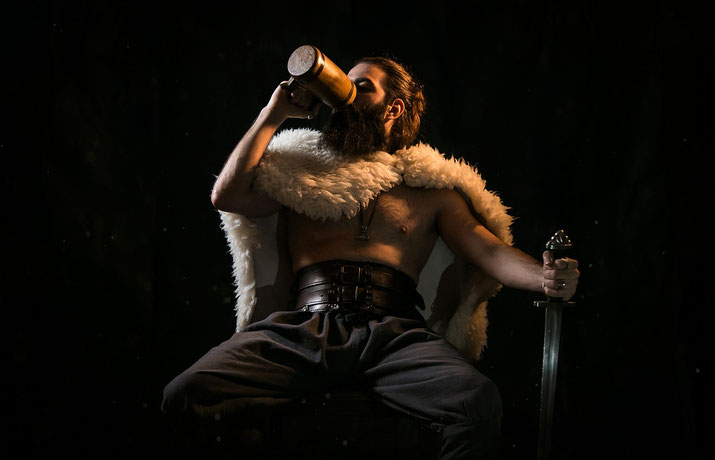Viking berserkers: The fierce and furious warriors of the Norse

The Viking Age, which spanned from the late 8th century to the mid-11th century, was a time of great exploration, conquest, and cultural exchange.
During this time, the Vikings, also known as Norsemen, ventured far and wide, leaving their mark on the world through their explorations, trade, and raids.
One of the most infamous aspects of Viking culture was the berserkers, legendary warriors who were feared for their fierce and uncontrollable fighting style.
Who were the 'berserkers'?
The origins of the berserkers are still a mystery, but it is believed that they were a special class of Viking warrior who possessed exceptional fighting skills and a unique mindset.
The word 'berserker' comes from the Old Norse 'berserkr', which means "bear-shirt."
This is because the berserkers were said to wear animal skins, often that of a bear, as they went into battle.
Some sources also indicate that they wore wolf skins, which may have given rise to the werewolf myth in Europe.
However, some scholars argue that the word berserkr could also mean "bare-shirt" or "bare-chested", implying that the berserkers fought without any armor at all, relying on their strength and endurance.
Much of what we know about berserkers comes from later Icelandic sources, especially the writings of Snorri Sturluson, a 13th-century historian and poet who compiled the Heimskringla and the Prose Edda.

Berserkers in battle
The berserkers were known for their incredible strength and stamina, as well as their ability to withstand pain and injury.
The most distinctive feature of the berserkers was their fighting style, which was described as a trance-like state of blind rage, known as berserkergang.
According to the sagas and other sources, the berserkers would howl like wild animals, foam at the mouth, and bite their shields.
During these frenzies, the berserkers would attack their enemies with reckless abandon and sometimes even turn on their own allies.
The berserkers were said to be immune to weapons and could continue fighting even after suffering severe injuries.
Enemies feared the berserkers, and their reputation for ferocity and unpredictability spread throughout the Viking world.
They were often used as shock troops in battle, charging into the fray and wreaking havoc on the enemy lines.
However, their unpredictable behavior could also be a liability, and some Viking leaders were wary of using them in battle.
What caused their 'battle frenzy'?
The exact cause of the berserkergang is still a matter of debate among historians and scientists. Some possible explanations are:
- It was a form of self-hypnosis or psychological warfare, used to intimidate enemies and boost morale.
- It was a result of a genetic condition or a mental disorder, such as epilepsy or schizophrenia.
- The berserkergang was induced by consuming certain substances, such as alcohol, mushrooms, or herbs.
- It was created through focused religious devotion or magic, inspired by Odin, the god of war and frenzy.
Their role in society
The berserkers were not a unified group or a social class, but rather individual warriors who followed their own codes and loyalties.
Some berserkers served as bodyguards or shock troops for kings and nobles, such as Harald Fairhair, the first king of Norway, who valued their ferocity in battle.
Others formed bands of raiders or outlaws who terrorized villages and towns. The berserkers were respected for their bravery and skill, but also feared for their violence and unpredictability.
They often violated social norms and laws, and were sometimes portrayed as villains or anti-heroes in the sagas, such as in the Egils saga.
Do we have any evidence that they existed?
The historical evidence of the existence of berserkers is somewhat limited and often subject to interpretation.
Most of the information we have about berserkers comes from medieval Norse literature and poetry, including sagas, skaldic poetry, and eddas, which were written many years after the Viking Age.
These sources provide descriptions of berserkers and their behavior, but they are not always reliable and may have been embellished or exaggerated over time.
The earliest depiction of a berserker-type warrior may be on the Golden Horns, artifacts that were found near Møgeltønder, Denmark. Dating from around AD 400, it shows two semi-naked warriors brandishing weapons.
The c. 7th century Torslunda plates, found in Öland, Sweden, depict a warrior wearing a wolf-skin headdress, possibly representing a berserker or úlfheðinn, and are among the few visual sources linked to the concept.
What happened to the berserkers?
The era of the berserkers came to an end with the Christianization of Scandinavia in the 11th and 12th centuries.
The new religion condemned the pagan practices and beliefs of the berserkers as demonic and barbaric.
The laws also became stricter and harsher against them, banning their rituals and punishing their crimes.
One of the last recorded mentions of berserkers was in AD 1015, when Jarl Eiríkr Hákonarson of Norway outlawed them in an effort to curb their violent and disruptive behaviour. Also, the medieval Icelandic law code, Grágás, explicitly condemned berserkers and their behavior, declaring them to be outlaws.
The Viking berserkers, though shrouded in legend, were among the most feared warriors in history, and were the epitome of the Viking spirit: fierce and furious.
What do you need help with?
Download ready-to-use digital learning resources
Copyright © History Skills 2014-2025.
Contact via email
With the exception of links to external sites, some historical sources and extracts from specific publications, all content on this website is copyrighted by History Skills. This content may not be copied, republished or redistributed without written permission from the website creator. Please use the Contact page to obtain relevant permission.





